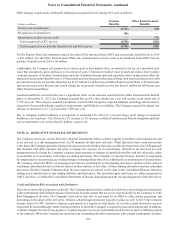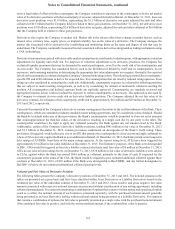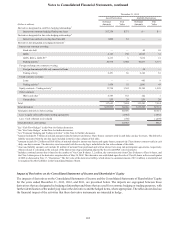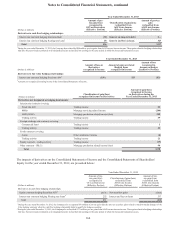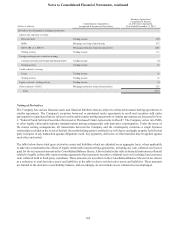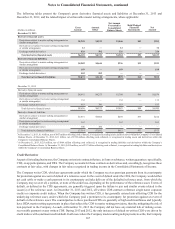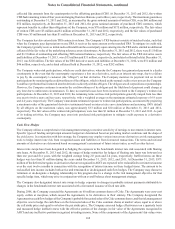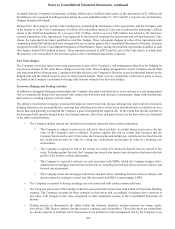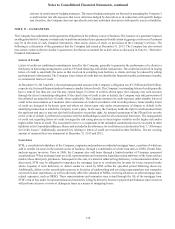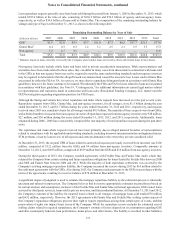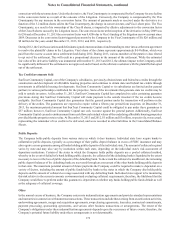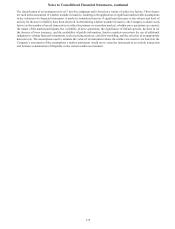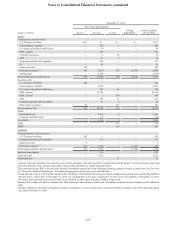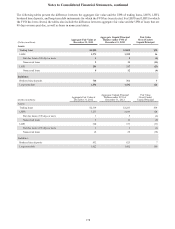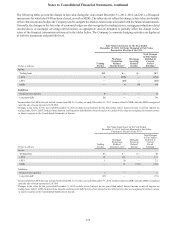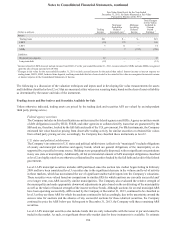SunTrust 2013 Annual Report Download - page 186
Download and view the complete annual report
Please find page 186 of the 2013 SunTrust annual report below. You can navigate through the pages in the report by either clicking on the pages listed below, or by using the keyword search tool below to find specific information within the annual report.Notes to Consolidated Financial Statements, continued
170
end user in certain macro-hedging strategies. The macro-hedging strategies are focused on managing the Company’s
overall interest rate risk exposure that is not otherwise hedged by derivatives or in connection with specific hedges
and, therefore, the Company does not specifically associate individual derivatives with specific assets or liabilities.
NOTE 17 – GUARANTEES
The Company has undertaken certain guarantee obligations in the ordinary course of business. The issuance of a guarantee imposes
an obligation for the Company to stand ready to perform and make future payments should certain triggering events occur. Payments
may be in the form of cash, financial instruments, other assets, shares of stock, or provisions of the Company’s services. The
following is a discussion of the guarantees that the Company had issued at December 31, 2013. The Company has also entered
into certain contracts that are similar to guarantees, but that are accounted for as derivatives as discussed in Note 16, “Derivative
Financial Instruments.”
Letters of Credit
Letters of credit are conditional commitments issued by the Company, generally to guarantee the performance of a client to a
third party in borrowing arrangements, such as CP, bond financing, and similar transactions. The credit risk involved in issuing
letters of credit is essentially the same as that involved in extending loan facilities to clients and may be reduced by selling
participations to third parties. The Company issues letters of credit that are classified as financial standby, performance standby,
or commercial letters of credit.
At December 31, 2013 and 2012, the maximum potential amount of the Company’s obligation was $3.3 billion and $4.0 billion,
respectively, for issued financial and performance standby letters of credit. The Company’s outstanding letters of credit generally
have a term of less than one year but may extend longer. If a letter of credit is drawn upon, the Company may seek recourse
through the client’s underlying obligation. If the client’s line of credit is also in default, the Company may take possession of
the collateral securing the line of credit, where applicable. The Company monitors its credit exposure under standby letters of
credit in the same manner as it monitors other extensions of credit in accordance with its credit policies. Some standby letters
of credit are designed to be drawn upon and others are drawn upon only under circumstances of dispute or default in the
underlying transaction to which the Company is not a party. In all cases, the Company holds the right to reimbursement from
the applicant and may or may not also hold collateral to secure that right. An internal assessment of the PD and loss severity
in the event of default is performed consistent with the methodologies used for all commercial borrowers. The management
of credit risk regarding letters of credit leverages the risk rating process to focus higher visibility on the higher risk and/or
higher dollar letters of credit. The associated reserve is a component of the unfunded commitments reserve recorded in other
liabilities in the Consolidated Balance Sheets and included in the allowance for credit losses as disclosed in Note 7, “Allowance
for Credit Losses.” Additionally, unearned fees relating to letters of credit are recorded in other liabilities. The net carrying
amount of unearned fees was immaterial at December 31, 2013 and 2012.
Loan Sales
STM, a consolidated subsidiary of the Company, originates and purchases residential mortgage loans, a portion of which are
sold to outside investors in the normal course of business, through a combination of whole loan sales to GSEs, Ginnie Mae,
and non-agency investors. Prior to 2008, the Company also sold loans through a limited number of Company sponsored
securitizations. When mortgage loans are sold, representations and warranties regarding certain attributes of the loans sold are
made to these third party purchasers. Subsequent to the sale, if a material underwriting deficiency or documentation defect is
discovered, STM may be obligated to repurchase the mortgage loan or to reimburse the investor for losses incurred (make
whole requests) if such deficiency or defect cannot be cured by STM within the specified period following discovery.
Additionally, defects in the securitization process or breaches of underwriting and servicing representations and warranties
can result in loan repurchases, as well as adversely affect the valuation of MSRs, servicing advances, or other mortgage loan-
related exposures, such as OREO. These representations and warranties may extend through the life of the mortgage loan.
STM’s risk of loss under its representations and warranties is largely driven by borrower payment performance since investors
will perform extensive reviews of delinquent loans as a means of mitigating losses.


